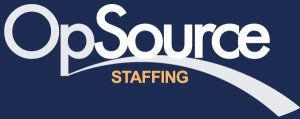Job-seekers and Employers, if you would like to discuss how OpSource Staffing Inc. can help you call us at (866) 870-8133 or Contact Us.
When getting ready for a job search, most prepare by updating their resume, scanning the job boards and considering which accomplishments to share during the interview. If you’re more nuanced, you might also consider who you’ll call to be references and if your navy suit in the back of your closet still fits. But few, if any, job seekers
prepare for the emotional journey of the job search. This is a very real part of the process and it can have a significant impact on your outcome. It’s very easy to sense a candidate’s defeat, frustration, and anxiety in the interview through subtle non-verbal cues, and unfortunately, many interviewers will interpret these as red flags (perhaps you’re hiding something?).
Chances are that’s not the case, but many assumptions go unchecked during the interview (very few hiring
managers are adequately trained on this important skill), so you don’t want to leave it up to chance that you’ll be able to completely regulate your emotions during the hiring
process. Even excitement can come across as desperation in certain contexts, so if you’ve not yet thought about how you’ll prepare for the emotional side of the hiring
process, here’s your chance:
Know the data. In the best of times, a job search
is a complete emotional roller coaster of high highs and low lows (even if you’re choosing to make a switch). If you’ve been forced to make a job change for any reason, it’s even more stressful. Layer on top of that an employer-favored job market, and it may seem more prudent to hire a therapist rather than a career
coach to help with the journey.
While the stress is very real, you have some control over keeping it in check, the easiest strategy of which is being ready for the roller coaster. For example, when you know that an average application to interview ratio is about 20%, you’re not terribly disappointed when your phone isn’t ringing off of the hook. Or when you accept that the odds of landing the job when called back for a second interview are about 25% – 50%, you won’t feel crushed when the offer doesn’t pan out. It’s not about being pessimistic, but rather realistic based on job seeker
data. On average, 250 applications are received for any advertised job, 4 -6 applicants secure an interview and one is hired. Recognizing the odds allows you to have a more balanced view, which means logic can temper emotions during the search process.
If you get more hits than the average job seeker, fantastic. In fact you can significantly tilt the odds in your favor by engaging your network (see below). But rejection is married to the job search
process (just like error is married to trial), so anticipate it, and don’t take it personally.
Check your expectations. Emotional waves are a part of any change process, but we have some control over the level of swing, which is usually influenced by expectations. Expectations drive those waves to be much bigger since they cause you to become emotionally-invested in an outcome (e.g., if you deem a certain role to be “the one” in your mind, but it fizzles out, then you’re crushed).
Approach each conversation with curiosity and interest, but avoid visualizing yourself in the corner office, making the commute or earning the higher paycheck too early in the process because this increases the emotional investment. If you find yourself ruminating about a role, jot down the pros and cons, which can help you to see the opportunity from a more balanced view instead of a glamorized one, which can ultimately mitigate the massive ups and downs.
This can also help you avoid a potentially poor decision. Emotions are very powerful and can override our logic when making choices (anyone who has dated can attest!), so if you invest in an opportunity too early, you may miss (or dismiss) red flags.
Take responsibility (but only for your part). The hiring
process is broken. Applicant Tracking Systems (ATS) weed out up to 75% of applicants before they even reach human eyes, sometimes based on irrelevant things like how a resume is formatted. That said, if your primary strategy for the job search
is applying online, you have some work to do. Networking has been shown to be the top strategy in uncovering new opportunities, and the only strategy to gain access to roles that are never published (which account for many more than you might think). In fact, 53% of candidates referred by a current employee landed the job and that number spiked to 91% when the person referring was at a Director level or above.
Another challenge beyond your control is that hiring
managers often aren’t trained to interview and are subject to their own emotional biases when making decisions. Since interviewing and selecting applicants is likely a peripheral duty they engage in a few times a year, most hiring
managers don’t get adequate guidance on how to identify their own unconscious bias, why it’s important to ask valid questions that relate to performance measures or how to dig into responses to check assumptions. This means that if you want a fair shot at landing the offer, it’s 100% your responsibility to show up to the interview ready to leave the information on the table that identifies your most relevant qualifications, regardless of the questions you’re asked.
Identify your triggers. And then, neutralize them. If a certain question throws you every time it comes up, this is an area that may need more attention. Developing a succinct, neutral response that is genuine and logical is a great first step. Rehearse it until you notice the feeling drain from the words, but be careful not to sound like a robot since an overly rehearsed response will sound canned and lead to probing follow up questions. Also, don’t forget to address the underlying issue of the trigger. If you’re angry about getting laid off, have a conversation with an objective friend, journal about your feelings or identify silver linings that help you move beyond the pain. Unaddressed emotions have a way of popping into the open at inopportune times, so simply masking them isn’t enough.
If your hot button tends to be the rising anxiety you feel when waiting on a response from the company, develop ways to mitigate this. A helpful strategy is having many balls in the air so that you’re so busy juggling applications, interviews, networking meetings and follow ups that you’re too busy to wait by the phone. Another strategy is clarifying “recruiter speak” so you both have the same interpretation. Hiring
moves at a glacial pace, so “we’ll be in touch soon” may mean by the end of the week to you, but by the end of the month to the company. Instead of guessing, at the end of the interview when you’re told “We’ll let you know about next steps”, simply respond, “That’s great – I’m excited about moving forward and will check in at the end of next week if I haven’t heard.”
Practice being objective.
Humans love to categorize and make meaning from experiences, often organizing them unconsciously as either good or bad, or some other label. These labels often elicit associated emotions (e.g., good = happy) and our brain continues to apply meaning to support these beliefs (e.g., this is a good job that would make me happy). While these strategies are often helpful in making us more efficient in daily tasks, they can get in the way of objectively viewing a situation. So, do your best to notice these categorizations so you can stop jumping to black and white conclusions, which can lead to emotional investment. Most things in life (including jobs) have many shades of gray. It can lead to deeper curiosity (which can lead to useful data) when you suspend judgment as you learn more about the role, company and your potential new colleagues. And, it’s often the stories we tell ourselves that lead to the emotional responses we experience, so be careful with the narratives you whip up.
Get support. Sometimes we need more assistance than our friends or family, or even a career
coach can offer. Humans are complex, the job search
is anxiety-inducing, and life rarely tosses us one challenge at a time. If you have additional life issues complicating your job search
or have experienced a particularly traumatic transition, you may decide that engaging with a therapist will help you to manage these challenges.
Emotions won’t stand to be ignored, so if you’ve been suppressing them, you may notice they’re seeping out in other ways including physical symptoms (e.g., sleep difficulties, digestive issues or headaches), relationship difficulties (e.g., increased irritability or arguments) or mental struggles (e.g., concentration or memory lapses). Your feelings will wait patiently for you, so while landing a new job is important, it may be prudent to put the search on hold for a short time to allow yourself some needed TLC.
Embarking on a job search
can be exciting. It’s energizing to envision yourself in a new role that taps into your strengths and supports your values. And just like any major change in life, there will be several complex steps on the path before you reach the destination. The more prepared you are for the various twists and turns, the more likely you are to be successful, and maybe even enjoy the journey.
Happy hunting!
Article Provided By: Forbes

Related Posts

By OpSource Staffing
•
23 Feb, 2021
Advantages: 1. Strategically balance labor needs and production levels by bringing in workers when they need them and then letting them go when they do not. 2. Convert a historically fixed labor cost to a variable one while shifting liabilities for unemployment, EEOC matters, benefits, and worker's compensation to a third party. 3. Use of contracted suppliers to manage low-skilled tasks leads to better outcomes at a lower cost. 4. Purchasing and finance departments save money on what companies pay for the hourly bill rate. Disadvantages: 1. Large disparity in pay between full-time regular employees and temps gives rise to a wide gap in the quality and dedication levels between the two types of workers. 2. Temporary workers display lower morale, higher absenteeism, greater turnover, less efficiency, and poorer work quality as compared to their full-time counterparts. 3. Decreased business efficiency as more labor hours are required to get the same amount of work done, largely due to exorbitant turnover and absenteeism, as well as constant restraining.

15 Jul, 2020
Career growth may seem like a controversial topic right now. Can you really have career growth in the middle of a global pandemic? Some people might roll their eyes at the thought or brush it off because it seems impossible. But what if it’s not? Whether you’ve been tossed into an unexpected job search or you’re secretly on the hunt for a new job, career growth should be your top priority. If you don’t make it a priority, you risk becoming stagnant, or worse, taking a step back in your career when it might not be necessary. But, even if it is a priority, you might not be taking it as seriously as you think. Here are five subtle signs you might be holding yourself back from career growth. You’re on cruise control or panic mode. This global pandemic has thrown tons of people into cruise control or panic mode. If you’re on cruise control, you’re probably telling yourself that now is not the time to make any sudden moves. Even though you’ve wanted to change jobs for a while now, you’ve likely convinced yourself that it’s best to keep your head down at work until the coast is clear. If you’re in panic mode, then you’re likely not thinking strategically about the next step in your career . You might be feeling like you have to take whatever you can get, without evaluating what you want or the various ways you can contribute to the next company. Both cruise control and panic mode are harmful to your career growth. Cruise control might feel safer, but it’s keeping you stagnant. Operating in panic mode might be stopping you from seeing all the ways you could successfully pivot your career and could have you taking detours you might not have to take. You’re not sure what career growth you want. Career growth looks different for everyone, especially right now. Career growth could mean more mentorship, more money, more leadership opportunities, more training and development, more impact, new challenges, a new industry, a better work environment, the list goes on and on. You may not want all of those things at once. You may not be able to get every single one of those things right now. But, it’s important to recognize which of those things are most important for your personal career growth so that you can at least try to aim for them. It’s like when you decide you want a specific car and all of a sudden you start seeing that car everywhere you go. But, if you never decided, you would’ve never noticed it passing you by. It’s the same way with career growth, if you don’t know what you want, you won’t have a clear focus moving forward and you’ll likely end up settling because you didn’t know what to pay attention to or ask for in your job search . You’re dwelling on the wrong things. It’s too easy to think negatively right now. But when it comes to your career growth, especially landing a new job that moves your career forward, thinking negative is 100% guaranteed to keep you stuck and stagnant regardless of how nice it would be to land a new job you’ll love. If you’re constantly asking yourself, “What if I don’t get it?” instead of, “How can I increase my chances of getting it?” then you’re spending too much energy entertaining negative possibilities when you could be welcoming positive ones. Instead of dwelling on the wrong thoughts and soaking up all the negative news, start paying attention to the things that are going right. Scroll down your LinkedIn feed and soak up the success stories of people celebrating accomplishments and starting new jobs right now, even if they are few and far between. Decide that it’s possible for you too. Attaining career growth is not just about doing the right things but thinking the right thoughts as well. You’re relying on motivation. No matter how well our intentions are, motivation is like that flaky friend who says they’re going to show up to the party but rarely ever does. When you’re worried about still meeting your deadlines, not catching coronavirus and landing a new job, you need something stronger than motivation if you want to make career growth a priority. You need a plan. When you have a clear and strategic plan on how to land a new job that will offer you the career growth you want, you can rely on discipline and consistency rather than motivation. You’re not strategic about getting support. You hear people say all the time, “network, network, network!” But, reaching out to strangers on LinkedIn expecting world-class advice and top-notch referrals without even building a genuine relationship or having a real conversation is not the way to go. Connecting with other professionals, and getting support from experts or career coaches, when done the right way, can be a catalyst for success. But if you have no clue how to do that, if you’re mass emailing people without any thoughtfulness, if you think getting support from a career coach is a luxury and not a necessity when you know you need guidance, then you’re not taking your career growth seriously and you should consider changing your approach. It is still completely possible to land a new job that moves your career forward, even right now. But it starts with you. If you know you’re guilty of one of these five things, that is good news! That means there is plenty of room for improvement and that you still have the power to move your career in a more satisfying direction. Article Provided By: Forbes

13 Jul, 2020
As of May 2020, the Bureau of Labor Statistics reported the current U.S. unemployment rate as 13.3%. While slightly down from April, unemployment is the highest it’s been since the 1930s. For many working Americans, this is the first— and hopefully last — time that we have seen anything like this. With millions of Americans now looking for work, employers need to rapidly adjust their workplace policies to remain competitive with top candidates. How Workplaces Have Changed In just a few months, the face of the American workplace has changed dramatically. March saw employees divided into groups labeled “essential” and “nonessential,” while stay-at-home orders forced teams to adapt to remote work. While some are returning to offices, job sites and other places of work, many employers are planning to permanently close some, if not all, physical locations. On May 12, Twitter made headlines as CEO Jack Dorsey announced that employees could work from home forever. This is just one of many companies reframing its view of the modern workplace. For those of us who have returned to our offices, we are met with sanitation stations, increased distance between desks, masks and other public health safety measures. Meetings are either stand-up only, with people practicing social distancing, or held virtually. What’s On The Horizon Some companies struggling with precisely how to adapt their current environment to new social distancing standards are considering adding staggered shifts to maximize space usage. In this scenario, multiple employees could share a single workspace but on alternating days, with a strict cleaning regiment in between. Along with creating a healthier environment (fewer people in close quarters), flexible schedules can allow for a reduction in office square footage. Businesses nearing the end of their lease can use this as an opportunity to downscale their office footprint and add to the bottom line. Many office space designers are considering how the change will impact future plans. For years, open office environments have been the trend. Cubicles have been replaced with standing desks, portable partitions and lots of room to roam. While closed offices and cubicles likely won’t return, it’s possible office buildings could transform from daily use facilities to places where meetings and conferences take place. National organizations may also begin opening regional hubs to provide coworking spaces for remote employees to use sporadically instead of congregating regularly in one central location. How Employers Need To Approach Hiring 1. Advertising And Follow-Through Once your team has reviewed which positions will be mission-critical for the remainder of 2020, actively advertise these jobs . A small investment combined with regular candidate follow-through will help eliminate concerns some job seekers have about the longevity of a new position. The first few emails and calls to a candidate help to set the stage for the relationship and establish your company’s culture in their mind. 2. Be Mindful Of Social Media How your organization is responding to the pandemic says a lot about your company’s culture and leadership. Candidates interested in working for your business are often actively following your posts, and their decision to join may be swayed by this content. Work with your social media manager to ensure posts come from a position of strength and positivity. 3. ‘What Have You Been Doing During This Time?’ While it may seem like an unusual question for an interview, the answer can tell volumes about the candidate’s work ethic and how serious they are about advancing their career . Many candidates are using this time to expand their knowledge and boost their skills. As you begin accepting résumés, keep an eye out for any new certifications awarded in 2020. Applicants who have invested in themselves may be a better long-term fit. 4. Establishing A Work-From-Anywhere Policy What once was a perk, the work-from-anywhere (WFA) concept may soon become the standard, and job seekers might consider it a necessity. Businesses that have put solid technology in place with clear WFA policies will likely be in a better position to attract top talent. Fairly soon, competition for candidates will become fierce. A recent Gallup survey found that 54% of office-based professionals would leave their job for one that offered flexible schedules and remote work opportunities. If you haven’t already made WFA part of your long-term business plans, you should consider doing so. 5. A Clear Public Health Plan A question bound to come up during an interview is how your company is helping to keep employees safe. While much of this article has focused on office-based professions, many of Ameri-Force’s employees work in the skilled trades, primarily in our nation’s shipyards. Most of the worksites have implemented rigorous health protocols, including daily temperature checks of all employees, frequent sanitation stations throughout the worksite, staggered shifts to increase social distancing and daily deep cleaning of surfaces. Make sure you’re relaying the steps you’re taking to candidates applying for job openings. 6. Act Quickly With millions of highly skilled Americans actively seeking work, now is the time to attract and retain the best talent. However, don’t wait too long to begin the hiring process. As states have begun to reopen, jobs are being added, and people are getting back to work. If you wait too long to hire, you may miss out on promising candidates who could have made a significant impact on your company. If you’re considering bringing on additional staff, now is the time. Article Provided By: Forbes
Celebrating 17 Years In Business 2007-2024



